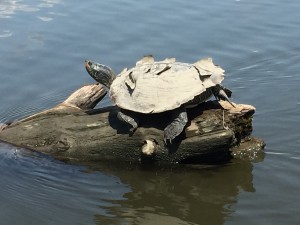I woke up contemplating the topic of my blog. The image of a turtle on a stump in the middle of Tivoli Bays, encountered on a canoe trip the other day, had stayed with me. I sat quietly and still while Jan channeled the Tuesday morning Soulbyte. The message she wrote sealed it, the topic of my blog became clear: change through stillness—the molting turtle.

– Photo by Erica Ketchel
It’s early spring in the Bays. All prepare for new life. Our trip was somewhat disruptive to the busy beavers, hunting eagles, wading herons, and the nesting geese. Most astonishing was the sighting of a statuesque, prehistoric looking turtle, perched on a log barely peeking above the water at low tide. At first, the question was: Is it really what it appears to be? Or is it simply a projection, the mind’s misinterpretation of matter that frequently shape-shifts things in this magical place?
Sure enough, it was what it appeared to be. As we approached, the turtle’s head appeared shiny and alive. Amazingly, it remained frozen, so contrary to the escapist behavior turtles usually employ when encountering human curiosity. The canoe drifted closer and the turtle form became increasingly evident, but still the questions arose. Could it really be alive? Is it somehow impaled on the stump? Then the canoe bumped right into the log; I could not control it and was frozen myself, not wanting to push off from the log and disturb this perched creature.
It was an amazingly powerful scene. What sat before us was a turtle whose outermost shell was molting, the sun’s deep rays hastening the peeling and flaking of its outer crust. Unfortunately, our closeness eventually overwhelmed its powerful intent to submit to the sun and it dove into the water for its own protection, in search of solitude to continue its transformative process in privacy.
The turtle’s journey of change so simply and eloquently mirrors our own, though we humans must employ consciousness to enact this ancient archetypal program of change.
The sun is our spirit energy, the kundalini energy of our energy body that infuses itself in our physical spine. In the first half of life that spirit energy must find its footing in the physical world, first lodging in the sacrum.
As we grow and mature the kundalini energy rises to our reproductive center where nature claims it for its own survival needs.
As we make our way into the world we need the confidence of autonomy and so the kundalini funds our ego stability at the level of the solar plexus, where we experience confidence and the extreme challenges of power and competition in this world.
As we approach the chasm of midlife—or in many instances much younger in today’s rapidly changing world—we approach the great ocean that must be crossed to reach the level of the heart, where truth, love, and compassion extend to all interdependent life.
With each of these rising changes we are challenged, like the turtle on the log, to stay contained, as the heat of kundalini rises in its upward ascent. If we can provide a sealed channel to the rising energy, it will ascend to the next level. But this does require stillness and containment, especially when the energy of the full moon beckons us to release and attach to the pleasures of the world.
If, for instance, the sexual urge of the second chakra is always catered to as it demands and beckons, how can we advance a relationship dominated by the compulsion of more? How, at the level of personal power, are we to advance if we allow the kundalini to leak out and attach to more possessions or conquests, as it so desires? Without the choice of containment that the turtle exemplifies, our spirit remains imprisoned in the dense desires of this world.

– Photo by Jan Ketchel
When we, as we must in our journey upward, explore and indulge in the kundalini attachments at the various stages, we are like the turtle that dives into the water, offsetting the drying-out transformation, as we binge in some form in this world. The process of absorbing and bearing the heat of containment, for our spirit to rise and change our focus, and for appreciation of our greater reason for being in this world, we must wait for another sunny day, beyond another Groundhog Day, when we are ready to steady for change.
I thank that turtle for so bravely bearing the tension of our intrusion, while also sharing one of life’s simplest yet most challenging of lessons: Activating change requires staying put and bearing the tension, as our defensive shell molts and sheds and our spirit rises to greater truth.
Seeking a new log for molting,
Chuck
